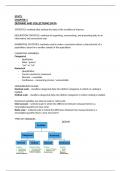Samenvatting
Constitutional Law (Human Rights Law) summary
- Vak
- Instelling
This summary covers Constitutional Law 312 which analyses human rights found in the Bill of Rights in the Constitution. These human rights include equality, political rights, freedom of expression, political rights, children's rights, and environmental rights. This summary is a comprehensive summar...
[Meer zien]











